
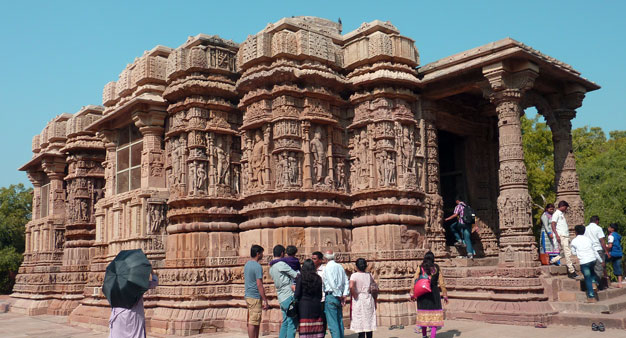 MODHERA SUN TEMPLE
MODHERA SUN TEMPLE
The
sun is the centre of our universe and all the ancients believed in sun
worship. In India the Gayatri hymn to the sun is considered to be the
greatest of all chants and has been scientifically proven to have
tremendous vibrations. The sun is the controller and prime mover of the
universe. The Gayatri mantra extols him as the basis of the spiritual
energy of the Supreme. The five names given to him in the Rig Veda are
Mitra, Surya, Savita, Poosan and Vishnu. These names indicate the
different functions of the sun. There are three famous sun temples in
India- Konarak in Orissa, Martanda in Kashmir and Modhera in Gujarat.
Of course there are a number of other inscriptions and stone sculptures
referring to sun worship which are found in many parts of India.
The first place on my list
after arriving in Ahmedbad was Modhera. The entrance to the site was
quite impressive and it was a joy to walk down the shaded avenue which
gave us a gorgeous view of the temple as we walked towards it. Every
time I see one of these exquisite poems in stone I’m struck with wonder
and anxious to know the minds of the sculptors who must have chiselled
away for years in order to produce these stone marvels.
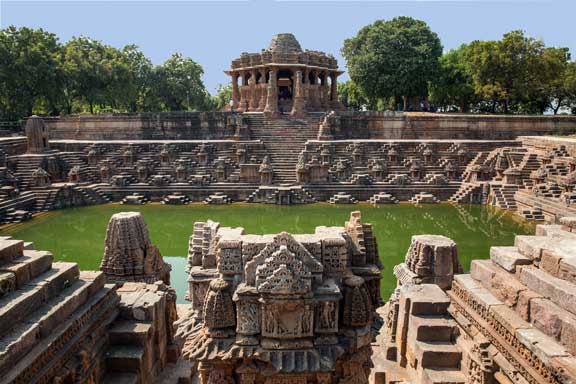 Surya Kund
Surya Kund
The first thing that strikes the eye is what is known as the Surya Kund
also known as the Rama Kund which is a series of steps leading
far down to the pond where one is supposed to take a dip before
entering the shrine of the sun god. There are a hundred and eight small
temples around the kund and four fairly large temples dedicated to Lord
Vishnu, Shitala Mataji, Nataraja and of Ganesha which is next to
Shitala Mataji. Later on when I visited the famous step wells for which
Ahmedabad is noted, I realised that they were masters in the art of
making these parallel steps which went down to the very bowels of the
earth leading to clear crystal water which never seemed to get scum on
top. After bathing in the Kund you have to climb up the steps again and
just before entering the courtyard of the temple there are two huge
pillars which were apparently used to be decorated with garlands and
flags showing respect for the deity.
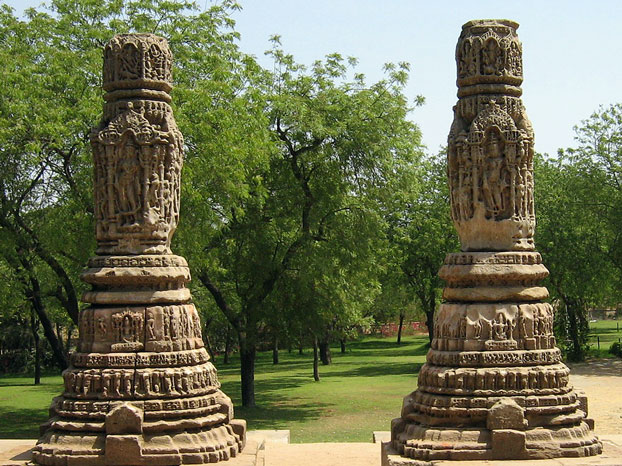
From here we come to
the court gallery filled with pillars which I later found was
fifty-two. I noticed that the pillars had scenes from the Ramayana and
the Mahabharata. I could close my eyes and envisage the scenes which
must have taken place in this place reserved for music and dance. I
could almost hear the tinkling of bells and the swish of the skirts
which the dancers wore. From there we entered the main temple with the
central dome which was the most conspicuous one when we entered the
first gate. Like Orissa most of the pillars had erotic carvings. Every
corner had an idol of the sun. The sanctum sanctorum (garbha griha) was
in pitch darkness and we had to climb up some steep steps with
difficulty and peep through a heavily barred door. Nothing could be
seen. Of course every single person there had a torch in their phones
so the fact that I didn’t have one didn’t matter. In the flickering,
eerie light all I could see was a deep hole or well or some such thing
which really looked like a black hole of physics. Later I found out
that the sanctum had contained a huge idol of the sun on his chariot
pulled by seven horses all made of gold. There was a priceless diamond
on the crown of the sun and at the beginning of the summer and winter
solstice, Uttarayana in January and Dakshinayana in July, the rays of
the sun penetrated through the walls or perhaps there was a hole
somewhere placed strategically to catch the rays. The temple faces the
east so that the rising sun at the equinoxes filters in a golden
cascade through its openings, from door way to corridor, past columns
and pillars to fall on the image in its innermost chamber. The rays
bounced off the diamond and the whole room used to be lit up by the
reflected rays of the diamond!
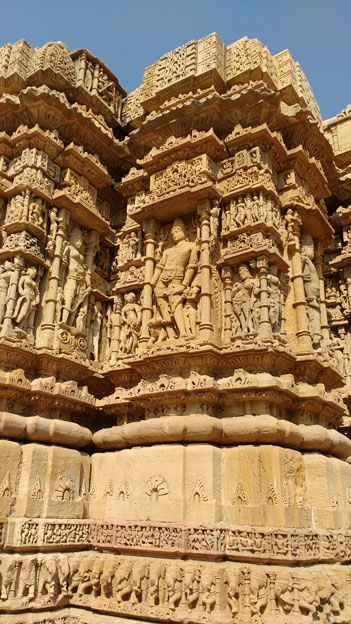 
Around this was the
corridor through which we could circumambulate the temple. Outside the
temple there were many carvings main amongst which were the twelve
figures of the sun god known as the twelve Adityas. These twelve names
are commonly repeated while doing the yogasana known as “Surya
Namaskara.” The recurring figure of Surya is that of him holding a
lotus in each hand and sitting in the lotus posture (padmasana). In
another form he has four hands and is seated in the chariot pulled by
seven horses with his lame charioteer Aruna who only directs the
chariot. Surya himself holds two lotuses in two hands and the reins in
the other two hands. The seven horses stand for a week of seven days as
well as the seven colours of a ray of sunshine. The two wheels of the
chariot stand for the two lunar fortnights, bright and dark. There are
female figures on either side of the chariot shooting arrows destroying
the darkness.
The sun temple at Konarak
has been constructed in the shape of a chariot while the one here is
made to resemble the petals of a lotus flower.
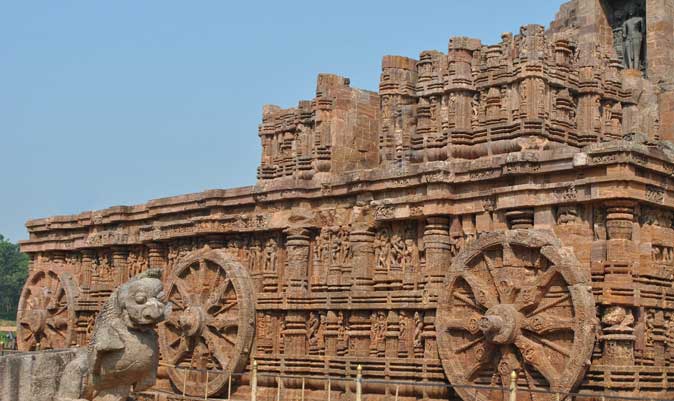 Sun Temple at Konarak
Sun Temple at Konarak
Every time I go to
these sun temples I am struck by the depth of the astronomical
knowledge of the ancient rishis. The sculptors must have been in a
state of ecstasy when they carved these exquisite figures for they must
surely have been pulled down from another plane of existence. They
allowed me to have a peep into that celestial realm from which they had
been drawn.
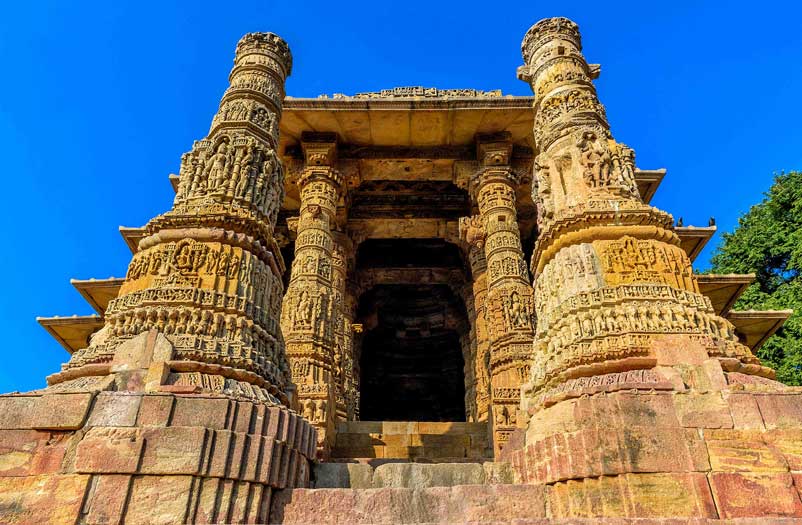
Hari Aum Tat Sat

PALITANA JAIN TEMPLES

In Hinduism many of
the holiest temples especially to Muruga and those to various gods in
the Himalayas are to be found perched on top of hillocks and mountains.
We believe that the arduous climb itself is part of the pilgrimage and
helps to create a particular state of mind which is receptive to the
vibrations found in the mountains and the temples. The Jains are also
of this opinion and you find that many of their famous temples are on
mountain ranges. They have five locations for their holiest cluster of
temples and this one on Shatrunjaya Hill, in Palitana is considered to
be the most important. The other groups are in Girnar (Junagadh), Mt.
Abu in Rajasthan, Bihar and Gwalior.
Such is the sanctity of
this place that every true Jain aspires to climb to the top of the
Shatrunjaya hill at least once in his lifetime. I had been warned by
well-meaning friends that the climb was extremely arduous, 1,800 feet
and about four thousand steps cut into the hill-side and that it would
be better to take the sling-chairs or palanquins which were available
in plenty to carry the sick and the old who could not walk. I certainly
belonged to the second category and I had decided the previous night
that I would take a sling chair. But that morning when I did the Guru
puja as I normally do on Thursday (Guru’s day), I felt my guru urging
me to attempt the climb. Why was I refusing to avail myself of this
golden opportunity to get extra spiritual merit just because I thought
my body couldn’t make it? “I will give you the strength,” he seemed to
say. The decision was made for me and that was a great relief.
We started from Bhavanagar
where we were staying and as soon as the car reached the precincts of
the Palitana temples the sling-chair boys crowded round us vying to
make us take their services. They were a bit disappointed when we said
that we had come prepared to walk. As a concession I told them that we
would avail of their services on the way down. There were strict rules
to be observed on the trek. We were not allowed to take any food. Only
water was allowed and this was provided in plenty at most of the stops.
Of course no phones or cameras were allowed. Everyone had to
leave the place before sunset since it was believed that the hill was
the abode of the gods and the sages. Not even the priests were allowed
to stay. Apparently all the Jain tirthankaras except Neminath had
attained nirvana at this holy site.
The first temple on the
route was a Saraswati temple. We had hardly gone up a thousand steps
when we saw some distraught people running down shouting out that there
were a swarm of bees just ahead and one of them had been stung. A
number of people including sling-chair users decided to turn back. Of
course I knew that this was only one of the tests which we had to face
and didn’t even bother to stop and listen to the whole of their story.
Needless to say we were not bothered by the bees at any time though we
could hear them buzzing about.
In the far distance we
could see the tops of the temples. However much we walked they seemed
to keep the same distance. Another test no doubt I thought to myself.
The chair boys were constantly keeping pace with us. Perhaps they hoped
that I might fall and they could pick up the bones and carry me up and
make some extra money. The fact is that once I decide to walk, I
usually never stop but would keep trudging at a snail’s pace which
eventually does reach the destination though very slowly. The boys had
told me that they took about one and a half hours to reach the first
temple of Adi Nath. I was surprised that I actually did it in two and a
half hours. It was surely a miracle.
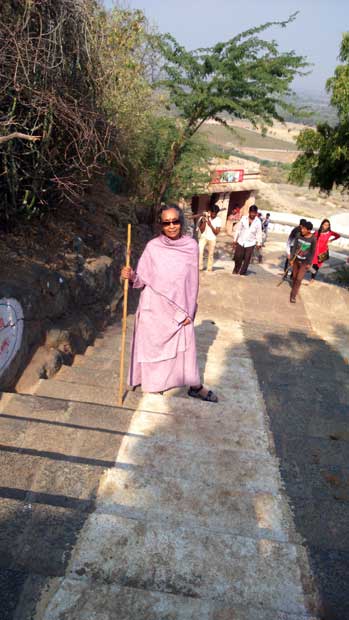
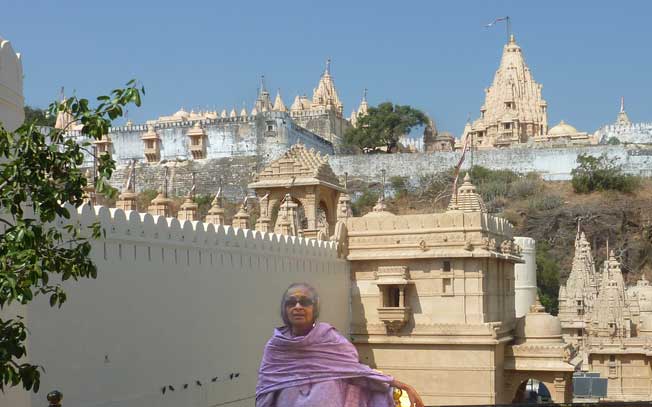
At last after two hours of
continuous walking we came to some plain ground which eased the effort
considerably but again the final peak with the dome of the temple still
seemed very high though the boys told me it was just round the corner.
At last at the end of a little over two and a half hours we came to the
first temple which was that of Adinatha. It was much later that I
learnt that Adi Natha or the first teerthankara of the Jains was indeed
Rishabha Deva who was a king who gave up everything and took to the
life of an avadhutha with absolutely no attachment to the body, who
lived like an animal without thought of the future, who wandered about
naked with absolute trust that God would protect him at all times. Such
people never begged or cooked food. They would eat if someone offered
them food and they would eat whatever was offered without even looking
at the contents. If someone gave them rotten food since they thought
them to be mad, they would still eat it and bless the person who gave
it to them. Rishabha Deva eventually gave up his body in a forest fire
on this very hill.
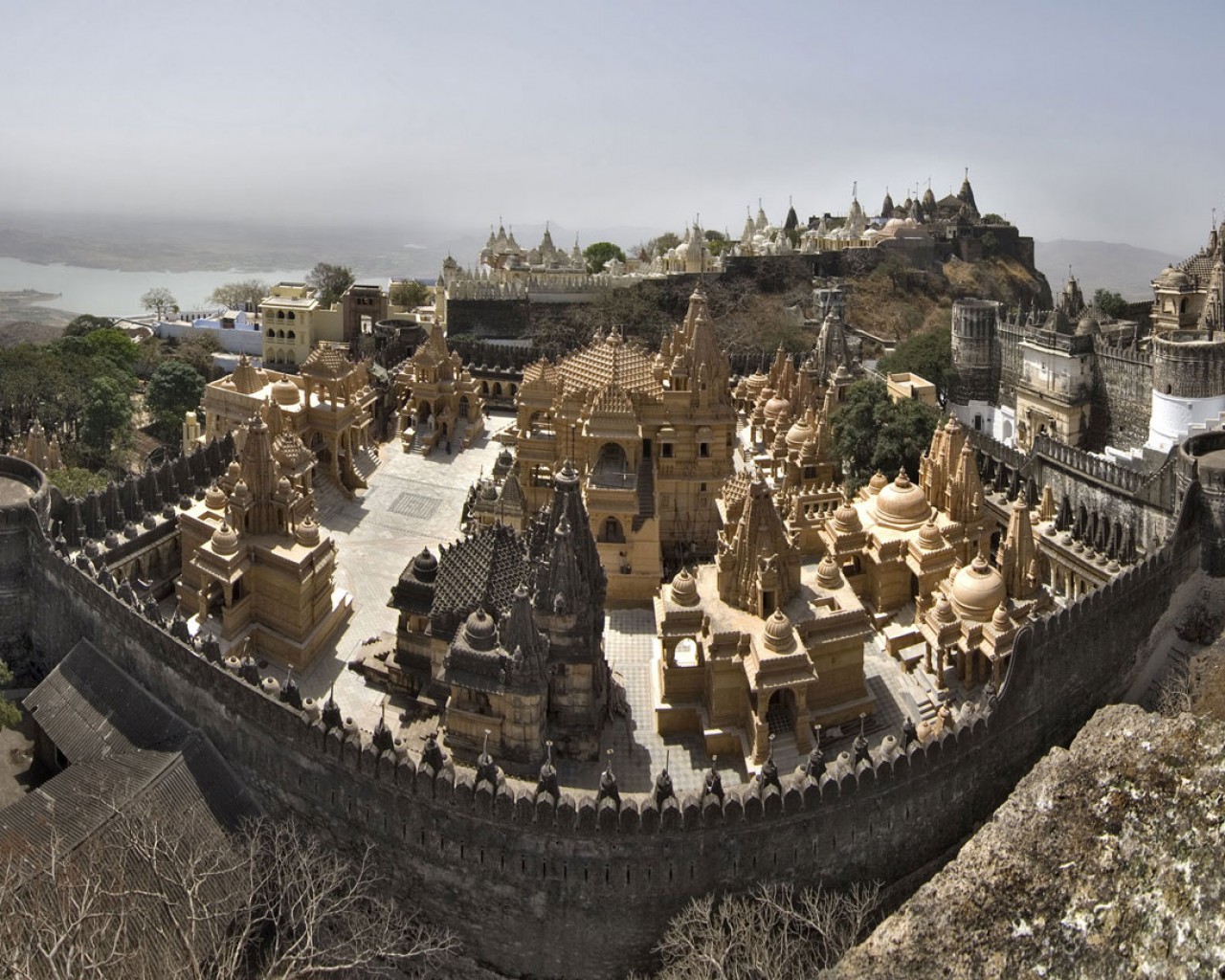
The sanctum sanctorum was
filled with the enormous statue of Adinatha. To me of course he was
Rishabha Deva or Adi Narayana and as I mentioned before this was
clarified later and proved to be true. The eyes were huge and brilliant
and boring into me, compelling me to go closer. I looked around and
found that there was a small ladies’ queue which seemed to be going
right inside. I ran to join this queue. I was the last of the ladies
and the men’s queue started right behind me. They courteously allowed
me to go before them and join the ladies queue. It was very slow moving
and suddenly the woman in front turned round and asked me if I had
taken a bath in the teerth which was attached to the temple. I shook my
head and she said that only those who had bathed in the holy water
would be allowed to enter the room of Adinatha. I didn’t know what to
do but the man behind me who had overheard the conversation asked me if
I had had a bath that morning. I said I had one in the hotel room in
the morning before coming, but not in the teerth since no one had told
me about it. He took up my case and told the woman that he would be
responsible for me and he would do the puja for me and that I could
enter provided I promised not to touch the idol. I nodded vehemently
despite the tears which were pouring down my cheeks. I covered my head
and my nose as I noticed everyone else doing it. All Jain monks did
this to prevent them from breathing any small insects through their
nostrils.
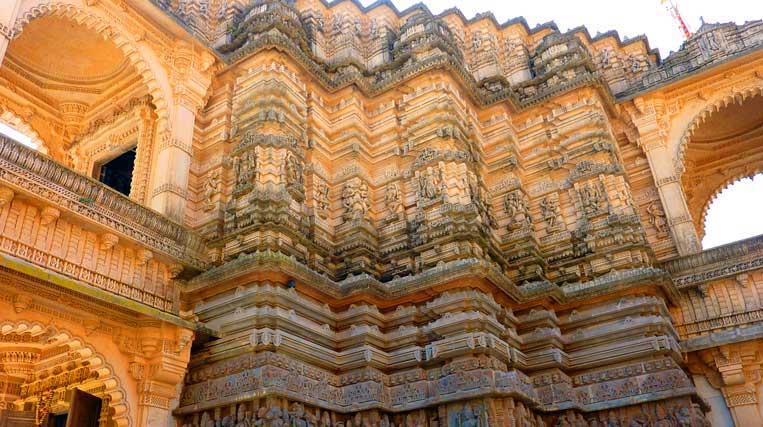
As we reached the door
to the garbha griha, (sanctum sanctorum) the man behind me relented
even further and thrust his plate with flowers and sandal paste into my
hands and told me that I could do puja if I wished! What could I say? I
was speechless with wonder and joy at the way that my Vanamali
supported me. I stumbled in since it was dark and my eyes were filled
with tears. The other ladies were standing on stools and applying
sandal paste all over Adinatha’s body. I felt that I was too unworthy
to do this but since the man had allowed me I applied sandal paste on
his lotus feet and felt tremors of delight pass through me at the
touch. I fell down and kissed his feet and prostrated again and again
and slowly went backwards into the entrance hall followed by his
brilliant gaze which had been boring into me from the time I entered
the hall. After sitting for a long time in the hall in front of him and
gazing into his compassionate eyes, I felt myself returning to a normal
frame of consciousness. The rest of the place hardly meant much to me.
I passed through other temples all exquisitely carved in marble and
stone with a wealth of detail which left one breathless.
It was getting very late
and I certainly did not have the strength or inclination to keep
climbing to the highest temple which was another five hundred steps
away. My cup of happiness was brimming over. What more did I want? I
had been blessed beyond all expectations. The return journey was also
an adventure. We sat in the swinging chairs carried on poles by a
couple of boys who jumped down the steps like mountain goats. I noticed
that they always asked us to get down on the level spaces. Perhaps that
was more difficult for them.
I really don’t remember
much of the return journey. My mind was filled with the brilliant eyes
of Rishabha Deva and I knew that he had truly blessed me or else I
would never have made it. I was expecting my calves to be paining badly
the next morning as they usually do when I do extra climbing but this
was another miracle that I didn’t feel even a twinge of pain.
hari aum tat sat
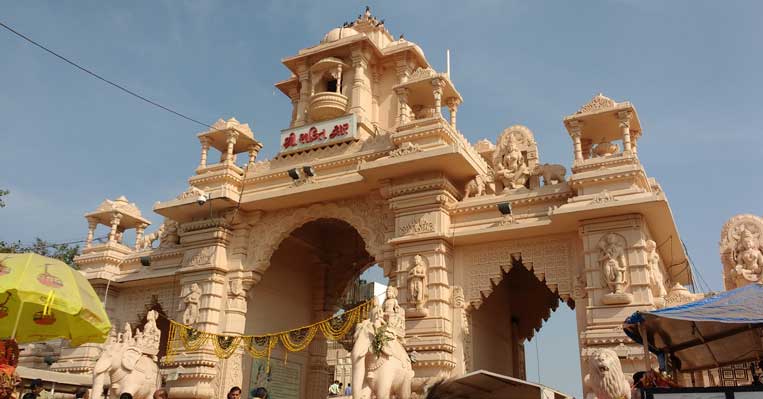
AMBAJI
One of the main reasons for
my going to Gujarat was to visit the famous Shakti Peeth called Ambaji.
We took a train from Ahmadabad to Abu Road and then a taxi to Ambaji.
It was past 10 pm when we reached so much as I wanted to, we were
unable to see the divine mother that night since the temple closes at 9
pm. We had already booked a hotel quite close to the temple and next
morning set off to join the queue for the morning arati. We could see
the golden turret of the goddess from the huge gate but we were not
allowed to go through that gate. Everybody had to form queues and
go through the corridors so that there was never any clutter of people
in the main courtyard. There were separate queues for men and women and
a passage left in the middle for emergencies. The arrangements were
really good and all along I could see resting rooms, baby changing
rooms, and play rooms. I’ve never seen anything like this in any of the
temples I have visited. Reached the main sanctorum after about an
hour’s wait in the queue. The idol itself could not be seen distinctly.
However I had seen her photos in many places and all of them depicted
her as “simha vahini” or seated on the lion holding aloft her sword and
with her feet on the demon of ignorance. As usual we were hardly
allowed to stand for more than a few minutes directly in front.
In other temples in India, the guards would shout and physically shove
you but here they only encouraged us to keep moving since naturally
everyone wanted a few minutes of bliss in front of her. Another
wonderful thing was that unlike other N. Indian temples there were no
avaricious priests waiting to pounce on the head of the hapless
pilgrim, determined to squeeze out some money from him. In fact in all
our travels in Gujarat I don’t think I ever saw a priest at all. There
was a boy standing here whose job was to give each pilgrim a knock on
his head with the silver slippers of the Goddess. In Tamil Nadu the
priest keeps a silver or gold crown on our heads for a second. Despite
the rush I deemed it a privilege to get a smart knock on my head before
being pushed by the people behind me. Hopefully the thump had knocked
the entire ego out of me!
I must admit that I was
feeling rather sad that I had not been able to see her true form. So I
was really happy when I found out that she had no true form! Apparently
there is a cave in the wall at the back in which the gold plated Shakti
Visa Sri Yantra has been installed. It is curved like the back of a
tortoise and contains the fifty one bijaksharas or letters which are
really mantras of the fifty one names of the goddess. This is the same
as the yantras found in Shakti Peethas of Nepal and Ujjain. Needless to
say no one is allowed to see this yantra. Even the priest who does the
puja has to blindfold his eyes and do the puja.
There are fifty one Shakti
Peethas or seats of the great mother goddess to be found, scattered in
different parts of India. These are all great centres of cosmic power.
They are actually the places where the parts of the body of Sati, the
wife of Shiva are supposed to have fallen. The twelve main Shakti
Peethas are Mahakali- Maha Shakti at Ujjain, Kamakshi at Kanchipuram,
Bramaramba at Sri Sailam, Kumari at Kanya Kumari, Ambaji at Gabbar
teerth, Mahalakshmi at Kholapuri, Lalita at Prayag, Allahabad, Vindhya
Vasini at Vindhyachala, Vishalakshi at Varanasi, Mangalavati at Gaya,
Bhavani in Bengal and Guhya Kesari in Khatmandu, Nepal.
Next morning we decided to
visit the holy place called Gabbar Theerth since this was the place
that Sati’s heart is said to have fallen. It is an ancient site which
has existed long before temple of Ambaji was built. It is on a
hilltop near the temple. A trip to this hill top especially on a full
moon day is said to be most auspicious. I was very happy since even
though we could not make it on full moon we were there for ekadasi or
eleventh day moon which is considered most fortunate. It was only later
that the yantra was transferred to the present day temple of
Ambaji. According to the scriptures Gabbar Tirth was situated on
the spot which was the origin of the great river Saraswati, in the
hills of Araasur in the forest known as Ambika. The Mahabharata says
that Rukmini had worshipped her family goddess, Ambika at this very
spot in order to get her beloved Krishna as her husband.
The hill was only 3 kms
from the township of Ambaji so we took an auto-rickshaw there and then
took the cable car which was plying up and down relaying thousands of
pilgrims to the top of the hill to the small shrine and then back
again. We reached the top after a long wait in the queue. It was a tiny
shrine with no particular idol but a yantra was displayed beneath the
shrine with which we had to be content.
The Devi Bhagavatam gives
the story of the ferocious asura (demon) called Mahishasura who used to
take on the form of a buffalo and who drove out the entire clan of the
gods from heaven and usurped their wealth. The gods were unable to kill
him and had to invoke the cosmic power known as Adi Shakti, the cosmic
mother goddess. Seated on her lion vehicle and wielding her sword she
is supposed to have killed the buffalo demon and hence she got her
famous appellation, “Mahishasura Mardini.”
The next morning we went
for another darshana at Ambaji before catching the train in the
night. It was Sunday and there was a big queue. I was determined
to go in, even though it probably meant having a two hour wait in the
corridors. Mohan decided not to wait in the queue and said he would go
and stand in the courtyard and try and get a glimpse from the outer
courtyard. As I was just going to join the ladies queue, I was thrust
by a policeman into the middle aisle which was always left empty in
case of an emergency. I couldn’t believe it and flew down the empty
aisle flanked by ladies on one side and gentlemen on the other. SHE
must have known of my aversion for crowds and getting into a flap since
I was always claustrophobic in the middle of crowds. After passing
miles of waiting pilgrims on either side I found myself bang on the
aisle leading to the sanctum. This Q was moving rather slowly and I was
really pleased since this meant that I could have a wonderful view of
the vague form of the goddess for a continuous period of time while
approaching the idol. Even though the form was still vague I could make
out that she was seated on a lion which had a lolling tongue and both
her feet came round the neck of the lion and rested on the demon below.
I reached there and got the usual knock on the head. I was truly in a
state of ecstasy since SHE had reduced my self- imposed punishment of
standing in the Q for a good three hours to less than half an hour!
What grace! My eyes streaming with tears I turned towards the exit and
was shocked to see Mohan standing there. He had reached the spot at the
precise moment that I had reached. Both of us were shocked. When we
went out he explained that he had been waiting in the outer courtyard
with no intention of coming in when he saw a huge bhajan party coming
in. Apparently the huge door on the side was opened whenever such a big
party appeared. Mohan jumped at the chance and followed the party into
the inner courtyard and then squirmed his way right up to the place
where I was standing so that we reached the front simultaneously. This
was such a miracle that my eyes welled with tears and I just couldn’t
speak. It was HER joke which she played on both of us!! I could almost
hear her tinkling laughter echoing down the corridor carried by the
breeze which suddenly started up.
It was a perfect ending to
our wonderful Gujarat trip. Such tremendous grace! That day was
Guruvayoor ekadasi day and Bhagavat Gita Jayanti. We were on a fruit
fast so I felt all our perceptions were sharpened and it was as if we
could really feel her sweetness and love in the flowing river, in the
soft breeze, in the stars and the moon which floated serenely in the
night sky as we drove to Abu Road.
Jai Mataji! Jai Ma Amba
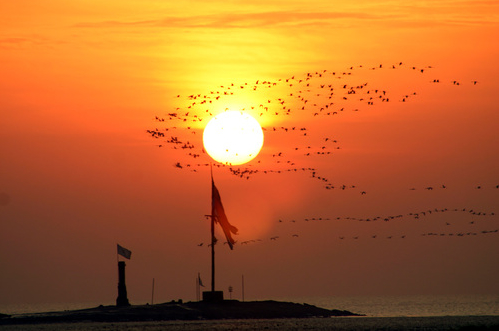 NISHKALANG MAHADEVA TEMPLE
NISHKALANG MAHADEVA TEMPLE
NISHKALANG MAHADEVA TEMPLE
We stayed a few days in
Bhavanagar in order to go to Palitana and one of the temples we visited
which I can only describe as unique was the Nishkalang Mahadeva temple.
It is in a small village called Koliyak on the Arabian sea. In fact the
temple is inside the sea and is accessible only during low tide.
On the day we went we were told that low tide was at 9.30 am so we went
a bit early at 8.30 am but unfortunately the tide had already come in
and all that we could see was the temple top and the flag fluttering
merrily in the breeze. It was quite a sight and I took a few photos
despite the fierce sun shining right into my eyes and despaired of
getting anything visible. But I was delighted to see that when the
photo was enlarged both the temple top and flag could be seen.
It was only later that I
found out the story connected with this amazing temple. As is common
with so many temples in India this also has a story associated with the
Pandavas and Lord Krishna. The five Pandavas were grief stricken at
having killed their cousins. In order to assuage their grief they
approached their friend and God, Lord Krishna and begged him to do
something for them. Krishna gave them a black flag and a black cow and
asked them to hold the flag and follow the cow. When both the flag and
the cow turned white it was to be taken as a sign that their sins had
been pardoned and they were supposed to meditate on Lord Shiva at spot.
The Pandavas wandered all over the country and when they reached
Koliyak beach both the flag and the cow became white. The brothers were
delighted and sat down to meditate on their tutelary deity- Shiva. Lord
Shiva appeared to each of them in the form of a lingam and each of them
worshipped the lingam which had appeared before him. The idol of a
Nandi (Lord Shiva’s bull) also appeared before each lingam. This is the
temple known as Nishkalanga Mahadeva. Nishkalang means pure and
guiltless. The Pandavas were totally cleansed and became guiltless
after worshipping Shiva in this fashion. Of course this happened over
five thousand years ago and the sea slowly encroached and covered the
temple. Today it can only be seen during low tide. Shiva is supposed to
have manifested himself to the Pandavas on the new moon (amavasya) day
in the month of Shravana (August/September). A fair is normally held
here on the amavasya day of that month and crowds come on that day.
There is a pond called the Pandavas pond and people have to wash their
hands and feet in this before going to the five lingams which are of
different sizes and spread across a square platform. The flag is
hoisted at the start of the festival by the Raja of Bhavanagar and is
changed only the next year. Apparently this flag never gets washed away
by the tide nor is it ever totally submerged during high tide. It was
never shaken even during the great earthquake of 2001. I was truly
happy that we were given a glimpse of this flag at least.
Aum Namashivaaya

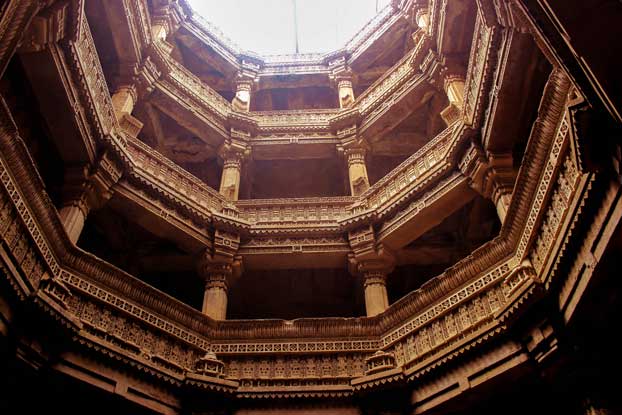
Step wells or stepped ponds are a common feature in many cities of
western India especially in Gujarat. They were used to collect water
during the monsoons. In ancient times, the villagers used to come to
take water daily and of course during periods of drought and even
caravans going from place to place used to stop and replenish their
water. They were made of different types of materials like mortar,
stucco, rubble and granite stones. The cylindrical shape was the basic
form used to deepen the wells. While the Brahmins were the architects,
the builders were artisans of Sompara sect of low–caste Hindus. A wide
gulf of religious distinction existed between the two groups, with the
former getting all the credit. However today we can infer that these
step wells have survived for such a long time due to the builders’
knowledge of the soil conditions as well as their ability to take into
consideration the earthquake proneness of the region. Some type of step
well was discovered in the Mohanjadaro sites also showing how the Hindu
tradition has been passed on and kept alive over the centuries.
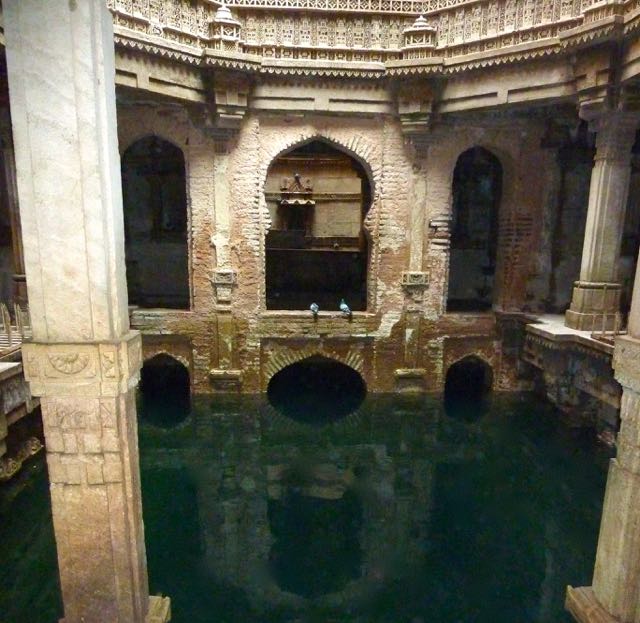
The step well at the village of Adalaj near Ahmadabad is the best
preserved and most popular. From the outside it is nothing much to look
at but when we went inside and as we started going down the steps
leading to the water, I was struck by the breathtaking beauty of the
carved panels on either side ending in water which was a pellucid blue
and absolutely without any scum. I’m sure it was much better than any
bottled water we could get in the market. The water was perfectly still
and mirrored the carvings on the walls on all sides. Two doves sat on
the opposite ledge cooing to each other and I was lucky to have got a
distant shot of them. I sat there for some time drinking in the beauty
of this amazing creation which had such utilitarian value as well. This
was one thing that you noticed in all ancient Indian architecture.
Beauty was part of utility. There never was anything which was made
only for utility. Everything had some carving or some attempt to
beautify it. A chair or a knife or a well or a book or mirror,
everything had to have some beauty in it. Beauty was itself a utility
since it produced such a profound sense of peace and well being in the
beholder as well as the user. Of course we took numerous photos which
hardly show the beauty of this amazing creation. One has to see it to
be able to absorb the beauty.
This well was built in 1498. There is an inscription in Sanskrit on a
marble slab in a recess on the first floor which gives all details
about the construction. It was started by Rana Veer Singh of the
Vaghela dynasty. However he was killed in a war with the Muslim king
Mahmud Begada of the neighbouring state. Rana Veer Singh’s widow was a
beautiful lady called Rani Rudabai who was totally bereft at the death
of her husband. She was anxious to finish the work he had started which
would be of immense benefit to so many people. So she agreed to a
proposal of marriage by Mahmud Begada on condition that he would
complete the building of the step well. Begada was totally overcome by
the queen’s beauty and agreed. He took over the work and did the
remaining bits in Indo-Islamic style. After completing the work he
reminded the queen of her promise to marry him. However the queen was
totally dedicated to her husband and having accomplished her purpose
she went round the well three times saying prayers and jumped into the
well and ended her life. All these scenes are depicted on the walls of
the well. To his credit, Begada allowed the well to remain without
defacing the architecture.
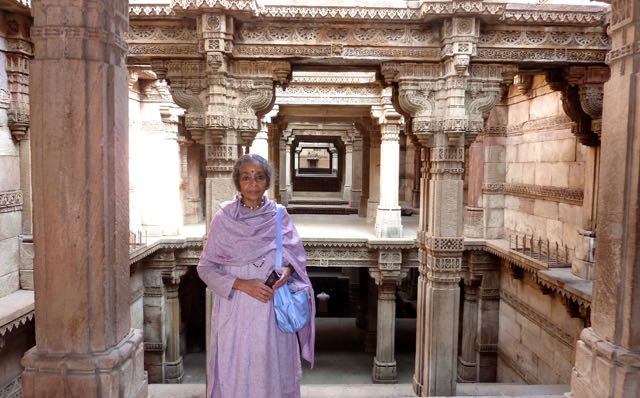
The Swaminarayana sect says
that before she died Rani Rudabai requested many saints to take a bath
in this step well so that the water would get purified by the touch of
the saints and thus deliver her from the sin of having contaminated the
water.
Apparently Begada asked the
six masons who built the well if they could build a similar well. When
they replied in the affirmative Begada sentenced them to death because
he did not want any other well like this one. The tombs of these six
masons are to be seen in the grounds next to the step well.
The temperature inside the
well is about five degrees lower than outside. No doubt this encouraged
villagers to come and loiter there while collecting water. Amongst all
the different types of sculptures the two most interesting which are
cut out of single blocks of stones is the Ami Khumbor or the pot of
life and the Kalpa Vriksha, the desire fulfilling tree. There is also a
fresco of the nine planets (navagrahas) which is supposed to scare off
the evil spirits.
Hari Aum Tat Sat.
|